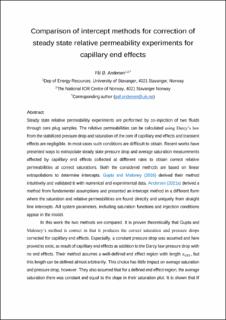| dc.contributor.author | Andersen, Pål Østebø | |
| dc.date.accessioned | 2023-03-15T09:57:00Z | |
| dc.date.available | 2023-03-15T09:57:00Z | |
| dc.date.created | 2022-03-03T20:21:35Z | |
| dc.date.issued | 2022 | |
| dc.identifier.citation | Andersen, P. Ø. (2022). Comparison of intercept methods for correction of steady-state relative permeability experiments for capillary end effects. SPE Reservoir Evaluation & Engineering, 25(04), 882-899. | en_US |
| dc.identifier.issn | 1094-6470 | |
| dc.identifier.uri | https://hdl.handle.net/11250/3058309 | |
| dc.description.abstract | Steady-state relative permeability experiments are performed by coinjection of two fluids through core plug samples. The relative permeabilities can be calculated using Darcy’s law from the stabilized pressure drop and saturation of the core if capillary end effects and transient effects are negligible. In most cases, such conditions are difficult to obtain. Recent works have presented ways to extrapolate steady-state pressure drop and average saturation measurements affected by capillary end effects collected at different rates to obtain correct relative permeabilities at correct saturations. Both the considered methods are based on linear extrapolations to determine intercepts. Gupta and Maloney (2016) derived their method intuitively and validated it with numerical and experimental data. Andersen (2021a) derived a method from fundamental assumptions and presented an intercept method in a different form where the saturation and relative permeabilities are found directly and uniquely from straightline intercepts. All system parameters, including saturation functions and injection conditions, appear in the model.
In this work, the two methods are compared. It is proven theoretically that Gupta and Maloney’s method is correct in that it produces the correct saturation and pressure drops corrected for capillary end effects. Especially, a constant pressure drop was assumed and here proved to exist, as a result of capillary end effects in addition to the Darcy law pressure drop with no end effects. Their method assumes a well-defined end effect region with length xCEE, but this length can be defined almost arbitrarily. This choice has little impact on average saturation and pressure drop, however. They also assumed that for a defined end effect region, the average saturation was constant and equal to the slope in their saturation plot. It is shown that if the region is defined, the average saturation is indeed constant, but not given by the slope. The correct slope is predicted by the Andersen model.
We also comment on theoretical misinterpretations of the Gupta and Maloney method. A few works have correctly calculated that the pressure drop over the end effect region is independent of rate, but not accounted for that its length is rate dependent. We show that the combined pressure drop is equal to a constant plus the Darcy pressure drop over the full core.
Examples are presented to illustrate the model behaviors. Literature datasets are investigated showing that (a) apparently rate-dependent CO2-brine relative permeability endpoints can be explained by capillary end effects and (b) the intercept methods can be applied to correct shale relative permeabilities. | en_US |
| dc.language.iso | eng | en_US |
| dc.publisher | Society of Petroleum Engineers | en_US |
| dc.title | Comparison of intercept methods for correction of steady state relative permeability experiments for capillary end effects | en_US |
| dc.type | Peer reviewed | en_US |
| dc.type | Journal article | en_US |
| dc.description.version | acceptedVersion | en_US |
| dc.rights.holder | The owners/author | en_US |
| dc.subject.nsi | VDP::Teknologi: 500 | en_US |
| dc.source.journal | SPE Reservoir Evaluation and Engineering | en_US |
| dc.identifier.doi | 10.2118/209797-PA | |
| dc.identifier.cristin | 2007473 | |
| dc.relation.project | Norges forskningsråd: 230303 | en_US |
| cristin.ispublished | true | |
| cristin.fulltext | postprint | |
| cristin.qualitycode | 2 | |
